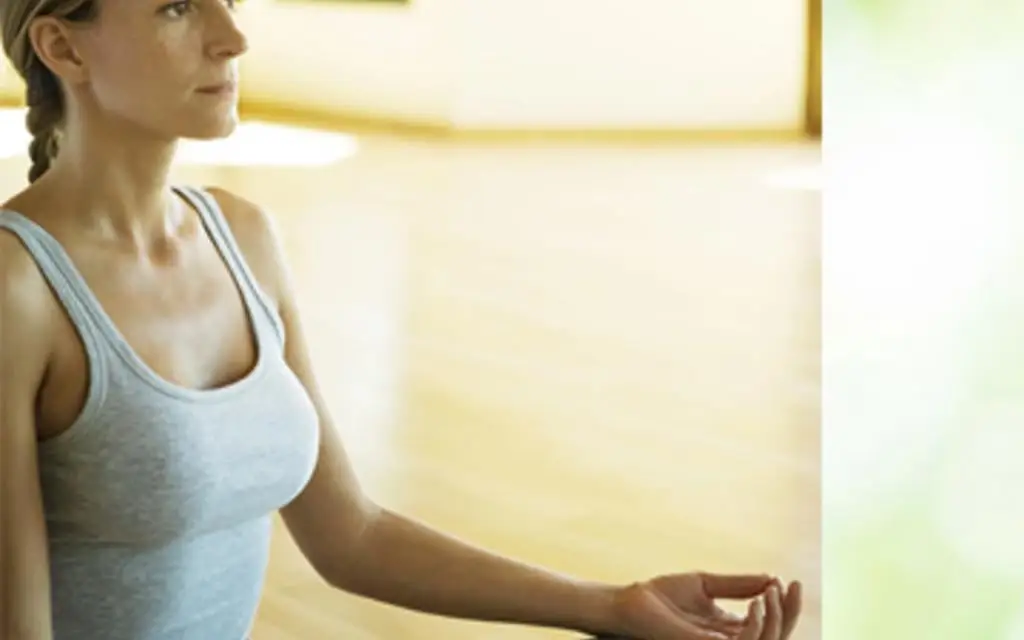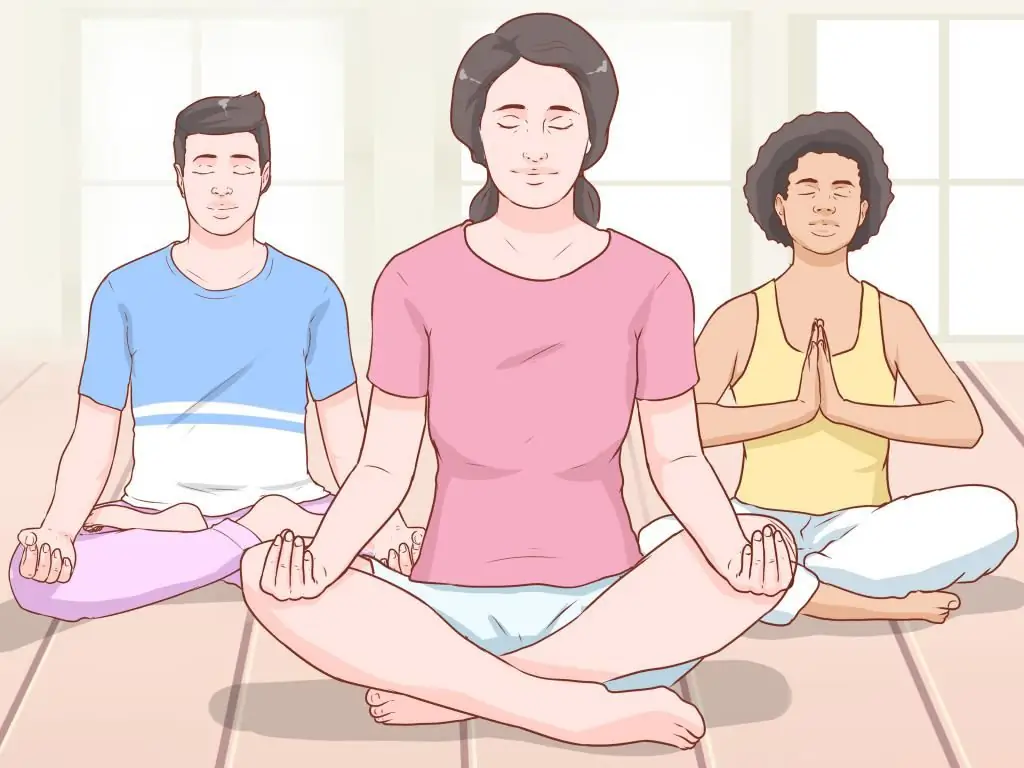- Author Miguel Ramacey [email protected].
- Public 2023-12-17 06:11.
- Last modified 2025-01-24 21:21.
Now there is a lot of talk about meditation, its beneficial effects on the body and the ability to concentrate. If you want to experience its effect for yourself, it's time to move from theory to practice. And here lies the biggest snag. How to start meditation for beginners? After all, you want to do everything right in order to achieve a 100% effect from the exercises. In this article, we will help you understand all the subtleties in the practice of meditation.
Believe me: you don't need to go to a special gym, have a lot of free time or be a super flexible gymnast. After all, meditation is far from yoga. Although this practice, if it becomes part of everyday life, will help you manage your mind and body. She will not make you a superman, but she will help you become a calm, balanced person. And what else do you need in our age of constant stress?

Benefits of meditation
A lot of wise words have been written about the beneficial effects of Eastern practices on the body. But meditation helps not only improve blood circulation, relieve muscle tension and normalize metabolism. First of all, it affects the consciousness of a person. Through this practice we will be able to:
- eliminate the effects of stress;
- relieve mental stress;
- achieve looseness;
- increase overall tone;
- get rid of worries;
- increase efficiency;
- feel the joy of life;
- get rid of insomnia, bouts of unmotivated anxiety;
- discover hidden creativity;
- increase self-esteem;
- hear the inner voice.
And if you do not know where to start in the first meditation, first answer honestly to yourself the question: why do you want to practice it. It doesn't matter what your motivation is. The main thing is that you yourself understand it well enough. This realization of the ultimate goal will help you to make the Eastern practice a part of your daily life.

Step one. Positive attitude
Our vain brain always fills the heart with anxiety. We are afraid that we are doing something wrong. That, in the end, there will be no positive effect. And when the result appears - how will we know about it? Do we have enough time to practice meditation? Where to do it? Are we young enough to meditate? All these and similar questionsconstantly drill our brains.
But the beginning of meditation is that we must let go of disturbing thoughts. Otherwise, nothing will work. This will no longer be meditation, but a psychoanalysis session with elements of self-criticism. So we have to be totally positive. Even if you are saddened by something or anxiety eats you up, leave all negative thoughts for later. If you are a believer, then it will not be superfluous to pray. After all, turning to God already brings the soul into the right state. However, you must understand that meditation is not a single exercise. It should become your daily practice.
Step two. A matter of time and space
There is morning and evening meditation. How to start exercising if time is running out? When is the best time to start exercising if you are a night owl? Yes, it is true that at dawn, with the rising of the sun, our physical and mental powers are most fully manifested. But don't reshape yourself to please the theory.
Meditation is a practice, and it is individual for each person. It doesn't take much time to practice. If you're in a hurry to get to work, set your alarm five minutes earlier than usual. The time for evening meditation is even easier to find. Practice it in the bath or while lying in bed. The place for meditation should be quiet, calm.
People with experience can practice outdoors, in parks, on the beach, but for beginners, a closed space is more suitable, where nothing distracts from the exercise. Turn on the light or dim it - it's up to you. Someone can not relax in the heat, the other - in the cold. Temperaturethe mode in the room is also up to you.
How to start meditation at home from scratch
Assume you don't know anything about Eastern practices. It's for the best. Focusing on results only hurts the whole thing. Here you just need to enjoy the process itself. Have you figured out why you meditate? Now try to get the most out of it.
Comfortable temperature in the room, sunlight or, conversely, muffled flickering of candles, silence or pleasant calm music - all this should help you relax. You can light more incense of your choice. Turn off your mobile phone so that an unexpected call does not interfere with meditation.
How to start exercising, how much time to devote to the first exercise? Five minutes in the morning and evening is enough. Beginners often ask the question: how can you focus on one thing if you don’t know how much time has passed? That's what an alarm clock is for! However, try not to make it sound too harsh.

Morning meditation. What pose to choose
There are many schools of meditation. But they all teach that exercise serves two purposes:
- Concentration of attention, charging with energy and vivacity, increasing overall tone.
- Complete relaxation, getting rid of stress, dropping a load of worries and anxieties, clearing the mind.
Needless to say which practice is good for the morning and which is good for the evening. If you want to recharge your batteries during the day, whichfull of work and trials, then the pose should be special. Do not be afraid that you are not in that physical shape to immediately sit down in the Lotus asana. This is not required from a beginner. First of all, you should be comfortable. Otherwise, the thought of stiff legs will negate all the benefits of the exercise.
Sit on the mat, and if necessary, on the pillow. Straighten your back, pull back the shoulder blades. Neck, spine and coccyx should be in line. If you find it difficult to maintain this position, lean against the wall. To get started, just cross your legs "Turkish style". If this is too difficult for you and after a minute your knees start to ache, change your position.
For a European, it is more accustomed to sit on a chair. But place the buttocks on the very edge of it so that the spine does not touch the back. Place your feet straight and place your palms on your knees. You can sit on your knees. The back should be straight. Put your hands on your hips. But over time, you will want to adopt the Burmese posture for meditation. It is similar to Lotus, but the feet do not fit on the thighs of the opposite leg, but on the lower legs.

Poses for evening meditation
This practice is aimed at maximum relaxation. Therefore, the posture must be different. It is best to lie on your back. It may be a bed, but then there is a big risk of falling asleep. If this happens, don't be discouraged: even taking two minutes to meditate will help you sleep better and be more alert when you wake up. But cases of falling asleep during the exercise are typical only for beginners.
How to meditate at home andnot sleep? Spread a blanket on the floor. Skip the pillow. Lie on your back. The head should be straight. It is permissible to tilt it slightly, but so that the neck is comfortable. Straighten your legs, slightly spread them to the sides. Hands should lie quietly on the sides of the body. This pose is also suitable for those who are contraindicated in sitting with a straight back (for problems with the spine).
For short relaxation meditations, you can lie on your stomach. This pose is especially suitable for women. How to start meditation at home? Spread a soft rug (or blanket) on the floor. Lie on your stomach with your face turned to the left. The hands should be at head level, palms down. Straighten your right leg and slightly bend your left leg.
Walking
This exercise is practiced not only in Buddhist, but also in Christian monasteries. The latter even have cloisters (courtyards with a gallery) or “labyrinths” lined with mosaics on the floor of the temple. It is useful to mark the beginning of the practice of meditation with such walking - to purify the consciousness, or its end as a phase of reflection.
With this exercise, the back and head should be straightened. Only the legs move, but the body remains motionless. Of course, it is difficult for a beginner to walk without waving his arms to the beat, without swinging his hips, but this habit will develop with time. Interlace your palms and place them on your stomach. With half-closed eyelids, but without tilting your head, focus on the ground or floor two meters from your feet. Even if you usually slouch, try to keep your back straight when walking like this. Then all the internal organs will take the right place andwill function correctly. It will also improve blood flow and brain function.
Step three. Choice of practice
Usually people find themselves a guru, a more sophisticated teacher who instructs, teaches and controls all phases of meditation. But such a person belongs to a certain school, current. And it’s not a fact that this practice is right for you. You have to figure out which meditation to choose. Where to start at home if you decide to focus on the subject? Select it first. It can be a burning candle - for beginners, the most suitable object, since bright light in the semi-darkness itself attracts attention.
If you have chosen the correct breathing meditation, then no additional equipment is needed at all. Just turn your hands palms up and close your thumb and forefinger. Although in this case, the audio track will help you in the exercise. It doesn't have to be relaxing music. There are audio tracks with birds singing, the sound of the surf, the noise of the forest. There is a school of meditation which is based on the repetition of mantras. Having chosen any of the many practices, you must adhere to it further. After all, meditation is to some extent a process of self-improvement. You cannot move in several directions at once.
Step four. Feel the heaviness of our body
All practitioners, whatever schools they belong to, are unanimous in their opinion on the topic of where to start meditation. The purpose of the exercises is to "refresh the brain", much like we restart a computer when it fails. Therefore, we should turn off for a whileyour thinking apparatus. But how to drive everything, absolutely all thoughts out of your head? To do this, the brain must concentrate on something very simple. This is an analysis of the state of our body.
We sit in a comfortable position for us. Feel your body getting heavy. Relax your face first. By the way, this is a useful exercise for those who want to get rid of not only unnecessary emotions, but also wrinkles. Let blissful languor descend on your torso. Wait until the relaxation reaches the tips of the fingers on the hands, and then to the shins and feet.

Step five. All attention is on the breath
At the first stage, thoughts are still bothering. But that shouldn't worry you. Many gurus explain how to start meditation for beginners. In parallel with relaxing the body, we should slowly focus our attention on breathing. It is not hard. In ordinary life, we breathe unconsciously, although it is the brain that commands the lungs to expand and contract.
But meditation is a process of controlled relaxation. We breathe exclusively with the stomach. We take air through the nose. We exhale through the mouth. We concentrate our attention on how the stomach swells and falls. If you are not the first time meditating, try to combine the fourth and fifth steps. Feel how your body relaxes with each exhalation. So the indefatigable brain will concentrate on the simplest things, and other thoughts (about work, problems, and so on) will simply recede.

Step five for practitioners of meditation,based on mantras
If you chose this school, then you will be all the more worried about the question: "Where to start meditation for beginners, especially if you study at home and alone." It will be more effective if you record the mantras on tape. Repeat the words behind the player. Aloud, in a whisper or even to yourself - it's up to you. There is no need to memorize the text - it overstrains the memory and interferes with relaxation.
But repeated repetition leads to automatic acceptance of words. They become organic to your consciousness. Later, the need for a player will disappear by itself. Mantras will become part of the processes of relaxation and concentration. But when phrases are memorized to automatism, a certain difficulty may arise. An indefatigable brain will throw thoughts at you in parallel with the pronunciation of mantras. He will delve into the past, analyze past events, or head into the future, making various plans. Take it with calmness. Just return to the awareness of the meaning of the mantra, focus on breathing and relaxing the body.
Step six. Become an outside observer
If we compare meditation with the process of rebooting a computer (in our case, the brain), then all the above practices were just closing programs. By concentrating on the subject, breathing, relaxing the body, we simply turned off our mind. These are preliminary steps. The purpose of the practice itself is to achieve a degree of complete detachment from thoughts. They may appear, but rush past like light clouds driven by the wind.
It's not easy for beginners to go intoastral How to meditate at home, you can tell in detail. But how to get out of yourself and become an outside observer? Modern man lives in an age of intense information flow. Many of what you have heard and seen you just have no time to "digest". Therefore, it is not surprising that the brain starts doing this when you are relaxed. This is what happens in those moments when a person falls asleep. But unlike sleep, you are in complete control of your mind. Let thoughts flow. The main thing is not to delve into them.
Balance between concentration and relaxation
A beginner may be tormented by various questions during the exercise. What is the right way to start meditation? Does it work for me, or did something go wrong? Did I get rid of thoughts the right way? How long have I been meditating? Did I manage to concentrate? Am I pronouncing mantras correctly? But these doubts are precisely the thoughts that interfere with meditation.
Compare this to the process of falling asleep. If we persistently, forcefully tell ourselves that we should sleep, nothing will come of it. But it is worth being distracted - and you will quickly plunge into a slumber. However, meditation is not sleep. You must keep a "hand on the pulse" of your breath, body. You can't let your mind wander. But there is a fine line between effort and lack of will. And in the question of how to meditate at home, for beginners, this problem is the most difficult.
Visualization technique
You can just watch the sunset. If you manage to devote all your attention to this spectacle for 30seconds, consider that you have already meditated. But another thing is when you are in a room where the objects are known to you and are no longer so interesting. Try to imagine different images. It can be a multi-colored fire, a kaleidoscope or something abstract.
The “Healing Qigong” school offers to start meditation to imagine yourself in some place where you felt good, calm, safe. It can be a park, a forest, a beach, a mountain peak, a church, and even a cozy cafe where you like to visit. The main thing is that it should be a suitable place in which peace and tranquility will descend on you. To enhance the effect of presence, you can turn on audio recording with the sounds of the forest, surf, babbling stream, and so on.
Meditation time
Do exercises better in the morning and in the evening. Gradually increase the time from five minutes to 15-20. How to start meditation in the morning? This is not physical exercise, where you need to jump out of bed and immediately do bends and lift dumbbells. You must completely get rid of the traces of a night's sleep. Wash up, make the bed. But don't eat breakfast. If you are too hungry, then eat something light. In the process of meditation, you should not be distracted by thoughts of food and rumbling in the stomach. But it is also impossible to eat especially densely. Do you already know how to start meditation? That's right, relaxation. But this will affect not only the arms and legs, but also the internal organs. The stomach will also slow down its work, and if it is full of food, this will negatively affect your well-being. In the evening, meditation should be practiced two hours after dinner.

A last few practical tips
Now you know how to start meditation. It remains to give a few general recommendations.
- First and most important: don't give up on failure. They happen to everyone. Perhaps on a certain day you are too excited to achieve relaxation and astralization. This is no reason to stop practicing meditation.
- Don't expect instant results. The first effect appears after 1-2 weeks after regular practice.
- Yes, classes should be daily. It is better to devote five minutes to meditation every morning than two hours once a month.
- It is important not only to start the exercise, but also to finish it.
- After meditation, do not rush to jump up from the mat. Your "computer" (that is, the brain) turned off during the reboot process. Now you need to wait until it works again. Sit for a while with your eyes closed. Be aware of yourself here and now. Say that you are the master of your own consciousness and are able to create your own life.






